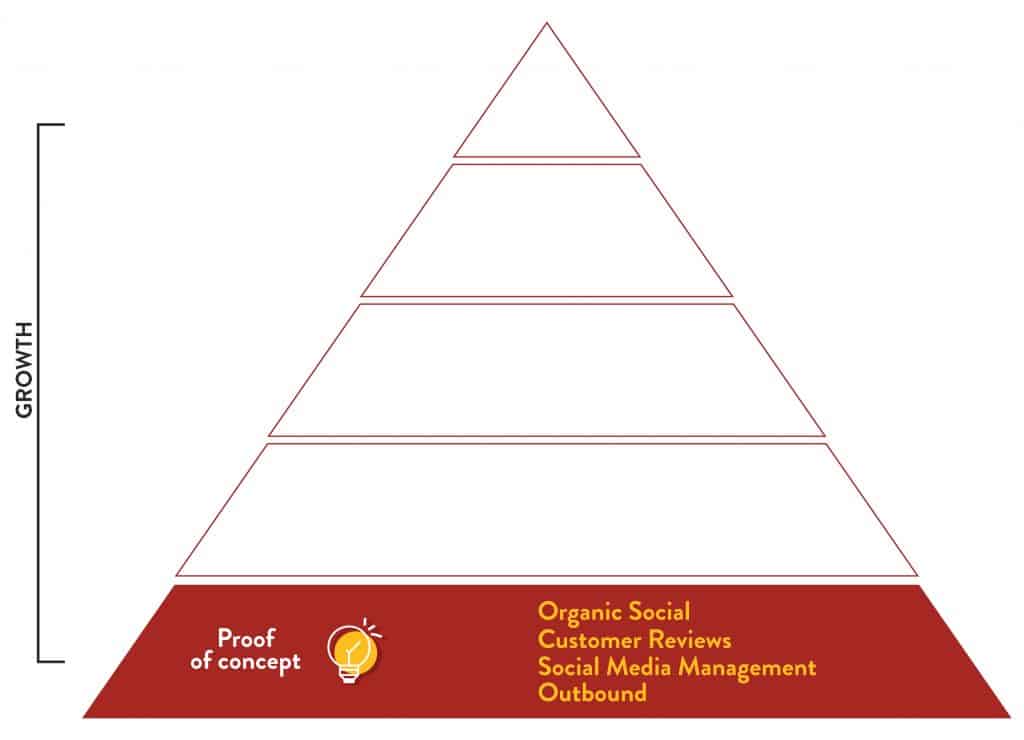eCommerce Marketing Hierarchy of Needs: Part One

This is the first entry in a five-part series of blogs we’ve dubbed the ‘eCommerce Marketing Hierarchy of Needs’. The objective for these blogs is certainly audacious. We aim to provide a simple framework for eCommerce businesses that helps to identify which marketing activities should be prioritized based on a company’s growth stage. We will help answer questions like: “should we be investing to improve our website’s user experience or is that time/money better spent on search marketing?” and “are we ready for marketing automation yet, or should we stick with just a CRM?”
We struggled with the scope of the blogs’ objective considerably and it spurred much internal debate. You see, at eBridge we never take a cookie-cutter approach to marketing; every client’s situation is different and what works for one doesn’t work for another. This runs counter to these blogs’ objectives of providing a general marketing framework. Also because the term “marketing” can refer to so many different types of activities, it was challenging to categorize them in a way that was both encompassing and simple. So please recognize this series for what it is: a well-considered albeit general framework, and certainly not a one-size-fits-all piece. Please contact us if you’d like marketing advice tailored specifically for your business.
For each tier in our hierarchy of needs, we’ll be looking at marketing from the perspective of five important facets:
- Customer Experience: How customers interact with your brand and complete purchases.
- Reputation: How customers learn your brand is legitimate.
- MarTech: How technology aids your marketing efforts.
- Search Marketing: How to utilize search to find customers.
- Paid Advertising: How to best spend your ad budget.
Tier 1: Proof of Concept
Proving a business concept is the first big step that any new company needs to take. This often involves nagging your personal network to purchase things they don’t really need, or soliciting them for feedback, while working out the kinks with your basic business model. One of the main challenges however, is in order to receive relevant feedback, the feedback must come from legitimate users of your product or service. The marketing tactics recommended at this stage are characterized by low cost, low time commitment, and are focused on getting that first handful of real customers:
Customer Experience: Organic Social
You don’t even need a website for proof of concept. Why waste the time and money on a website if the concept isn’t going to work anyway? Many small businesses run their stores through Facebook because it’s simple to get started and provides easy access to an audience (your personal network). Another alternative would be to use a website builder to throw up a quick and dirty website, and then promoting that via a Facebook/Instagram page.
Reputation: Customer Reviews
Even for companies just starting out, having positive customer reviews will go a long way towards garnering credibility. Another benefit of using Facebook is the ability for customers to leave reviews easily on your page. Google Reviews are also important, as potential customers researching your company will often encounter them when available.
MarTech: Social Media Management
A social media management tool like HootSuite (with freemium options) will help maximize the impact of your organic social media efforts by allowing you to post across multiple channels, schedule posts, and have access to basic analytics.
Search Marketing: Outbound
Search marketing, whether paid or organic, is considered an inbound marketing tactic because customers are actively finding you. But at the ‘Proof of Concept’ stage, it usually doesn’t make sense to invest in SEO which is a longer term strategy, nor PPC which can be expensive and time consuming. Instead, we’ve flipped it and invented a new term, “outbound search marketing”, to refer to grassroots activities where the business owner/manager/marketer is the one doing the searching. This includes finding new customers via Meetups, local business groups, community events, social media groups, message boards, etc. This will provide unbiased feedback from customers you don’t know personally, as opposed to the family and friends you’ve been nagging.
Paid Advertising: None
It usually doesn’t make sense to spend money on advertising if you haven’t proven your business model yet. In the very early-going, you want to make mistakes as cheaply and quickly as possible and paid advertising is seldom cheap.
Thanks for reading! For the next blog in this series, we’ll advance to the second tier of the eCommerce Marketing Hierarchy of Needs. The next tier after your business concept is proven is all about getting a basic eCommerce website up and running. We will analyze which marketing tactics you should prioritize using the same five facets: Customer Experience, Reputation, MarTech, Search Marketing, and Paid Advertising. You can subscribe to our newsletter to ensure you don’t miss the next post!
Questions? Comments? Vehemently disagree with our framework? We’d love to hear from you!
Thanks,
Devin Rose
Posted December 23, 2017
Categories: Hierarchy of Needs,
Business Growth
Tags: Advertising, Customer Reviews, Hootsuite, Marketing Tools, Organic Social Media, Social Media, Startup

